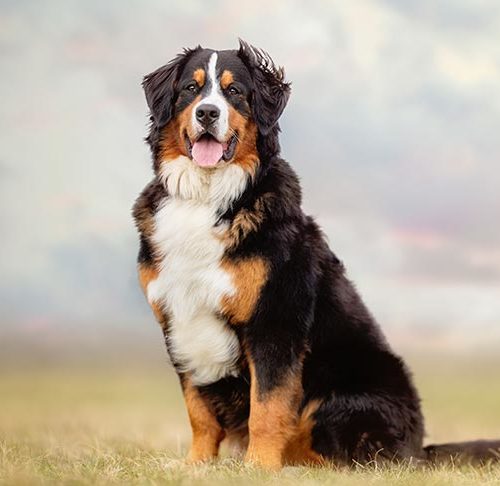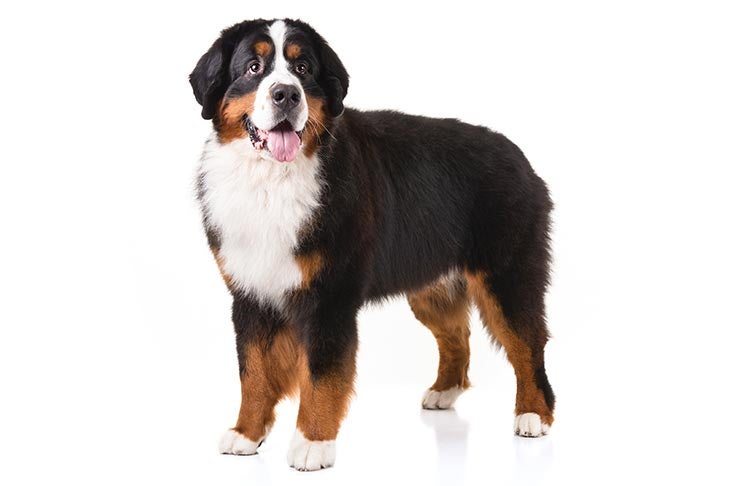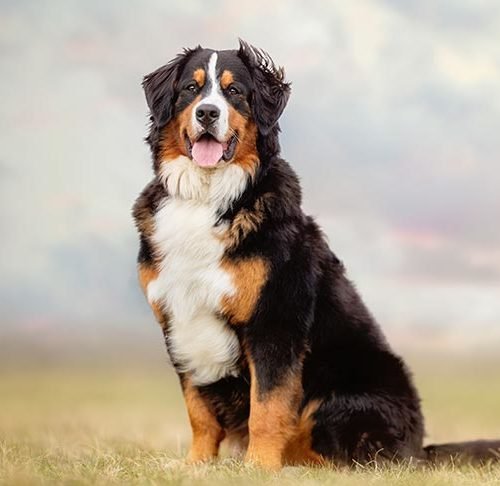You might have seen them before—those big, fluffy dogs with wagging tails and friendly demeanor. So why are they called Bernese Mountain Dogs? Well, it’s a fascinating story that takes us to the beautiful mountains of Switzerland.
These lovable canines get their name from the place they originate from—the Bernese Alps in Switzerland. These majestic mountains provide the perfect backdrop for these magnificent creatures.
In the small region of Bern, these dogs were bred and used as working dogs for centuries, helping farmers and herders with various tasks. Their strength, intelligence, and gentle nature made them popular companions in the Swiss countryside.
Bernese Mountain Dogs have a captivating history that sheds light on their name. These loyal and lovable canines were originally bred in the Swiss Alps, where they assisted farmers with various tasks. The Bernese Mountain Dogs’ name originates from the region they came from, the canton of Bern, in Switzerland. Their sturdy build and adaptability made them essential working dogs in the mountainous terrain. Today, Bernese Mountain Dogs are beloved companions known for their gentle nature and protective instincts.

Why Are They Called Bernese Mountain Dogs: Unraveling the Name and History
When it comes to dog breeds, the Bernese Mountain Dog stands out with its majestic appearance and gentle nature. But have you ever wondered why they are called Bernese Mountain Dogs? In this article, we will delve into the fascinating history behind the name and uncover the origins of this beloved breed.
The Origins of the Bernese Mountain Dog
The Bernese Mountain Dog, or “Berner” as they are often affectionately called, originates from the Swiss Alps. They were initially bred for working purposes, primarily as farm dogs. These canines were skilled in herding livestock, pulling carts, and guarding property. Their strong physique and kind temperament made them ideal companions for the farmers in the mountainous regions.
It is believed that the Bernese Mountain Dog shares its ancestry with the Roman Molosser dogs that accompanied the Roman legions as they traversed the Alps. Over time, the breed adapted to the harsh alpine climate and developed a thick, tri-color coat to protect themselves from the elements. This evolution, combined with their working abilities, set the foundation for their modern-day name.
The Significance of the Name
The name “Bernese Mountain Dog” is a direct reflection of the breed’s origin and purpose. The first part of the name, “Bernese,” refers to the Swiss canton of Bern, where the breed was most prevalent. This region is known for its picturesque landscapes and rugged mountains, which served as the natural habitat for these dogs.
The second part of the name, “Mountain Dog,” highlights the primary function of this breed: working in mountainous terrains. These dogs were specifically bred to excel in navigating challenging elevations, making them indispensable for farmers in the region. Their strong work ethic, intelligence, and adaptability made them highly sought after.
Today, Bernese Mountain Dogs can be found in various parts of the world, but their name remains a testament to their historical roots and purpose. These beloved canines have transitioned from working dogs to cherished family pets, known for their loyalty and affectionate nature.
The Bernese Mountain Dog in Popular Culture
The Bernese Mountain Dog’s endearing qualities have captured the hearts of many, leading to their appearances in popular culture. One notable example is the character “Beethoven” from the famous family film series. Beethoven, a lovable and mischievous Saint Bernard, symbolized the gentleness and playfulness of the Bernese Mountain Dog breed to a wide audience.
In addition to their on-screen presence, Berners have become popular social media stars with their adorable photos and videos capturing the hearts of millions. Their expressive eyes, fluffy fur, and unwavering loyalty make them perfect subjects for viral content. It is no wonder that people across the globe have fallen in love with Bernese Mountain Dogs.
Caring for Bernese Mountain Dogs
As with any breed, caring for Bernese Mountain Dogs requires attention to their specific needs. Their thick, double coat necessitates regular grooming to prevent matting and keep their fur healthy. Additionally, their large size and love for exercise mean ample opportunities for outdoor activities and mental stimulation.
Proper nutrition is essential for the overall well-being of Bernese Mountain Dogs. A balanced diet with high-quality dog food formulated for large breed dogs is crucial to maintain their optimum health. Regular veterinary check-ups, vaccinations, and preventive care are also vital to ensure they live happy and healthy lives.
Conclusion
Bernese Mountain Dogs represent a delightful combination of history, purpose, and companionship. Their name pays homage to their Swiss origins and their significant role as mountain working dogs. Today, they continue to capture the hearts of many with their lovable nature, making them a beloved breed both in real life and popular culture. If you have the privilege of sharing your life with a Bernese Mountain Dog, you will undoubtedly experience the joy and devotion that they bring to every moment spent together.
Key Takeaways: Why are They Called Bernese Mountain Dogs
- Bernese Mountain Dogs are named after the Swiss region they originated from, Bern.
- They were traditionally used as working dogs in the Swiss Alps to pull carts and herd livestock.
- The word “mountain” in their name refers to their history of working in mountainous regions.
- They have thick, double coats that help protect them from the cold weather in mountainous areas.
- The name “Bernese” distinguishes them from other Swiss mountain dog breeds like the Greater Swiss Mountain Dog.
Frequently Asked Questions
Welcome to our FAQ section on Bernese Mountain Dogs! If you’re curious about why they are called Bernese Mountain Dogs, you’ve come to the right place. Here are some common questions people have about this unique breed:
1. Where do Bernese Mountain Dogs get their name from?
Bernese Mountain Dogs get their name from the region they originated in – the Bernese Oberland in Switzerland. They were highly valued as working dogs in this mountainous area, assisting farmers in various tasks, such as pulling carts and herding cattle. Their name serves as a tribute to their roots and their purpose in the Bernese Oberland.
Interestingly, in their native language, Bernese Mountain Dogs are called “Berner Sennenhund,” which translates to “Bernese Alpine Herdsman’s Dog.” This further highlights their association with the Swiss mountains and their important role in the region’s farming community.
2. Are all Bernese Mountain Dogs from Switzerland?
Yes, Bernese Mountain Dogs are indeed from Switzerland. They are one of four Swiss mountain dog breeds and are specifically linked to the Bernese Oberland region. This breed’s history dates back hundreds of years, where they were bred for their hardworking and versatile nature.
Nowadays, Bernese Mountain Dogs can be found all around the world, but they still hold a special place in Swiss culture and heritage. Their popularity has led to their spread across different countries, where they continue to steal hearts with their friendly and gentle nature.
3. Do Bernese Mountain Dogs live in the mountains?
Although Bernese Mountain Dogs have “mountain” in their name, they don’t necessarily live in the mountains. These dogs were initially bred to work in the Swiss Alps, but they adapt well to various environments and make great companions in suburban and rural areas as well. They enjoy spending time outdoors, going on walks, and engaging in activities with their owners.
While Bernese Mountain Dogs can handle colder climates, they are susceptible to heat due to their thick double coats. It’s important to provide them with plenty of shade and fresh water during warmer months to keep them comfortable and safe.
4. How did Bernese Mountain Dogs become popular as family pets?
Bernese Mountain Dogs became popular as family pets thanks to their lovable and gentle nature. These dogs have a knack for forming strong bonds with their human families and are known for their patience and affection towards children. Despite their large size, they are typically calm and well-mannered, making them great companions for families of all sizes.
Additionally, their striking appearance – with their thick coat, expressive eyes, and friendly demeanor – captures the hearts of many. Their adaptability to different living situations and their eagerness to please their owners further solidify their popularity as family pets.
5. What are some unique characteristics of Bernese Mountain Dogs?
In addition to their name and origin, Bernese Mountain Dogs have several unique characteristics. First and foremost, their distinctive tricolor coat catches the eye, featuring a mainly black body with white markings and tan highlights. This beautiful coat requires regular grooming and maintenance to keep it in good condition.
Another notable characteristic is their calm temperament. Bernese Mountain Dogs are typically even-tempered and friendly, making them excellent therapy dogs or companions for people with disabilities. Their loyal and patient nature adds to their charm and makes them beloved pets in many households.

Bernese Mountain Dogs 101: Everything You Need To Know – Is It the Right Dog for You?
Summary
So, why are they called Bernese Mountain Dogs? These furry friends got their name from the Bernese Alps in Switzerland where they were first bred. They were originally used as working dogs on farms, helping with herding and pulling carts. Today, they are loved for their friendly nature and loyalty, making them great family pets. Bernese Mountain Dogs are known for their striking black, brown, and white coats, and their large size. They are gentle giants and are often seen as a symbol of Swiss heritage.
If you ever meet a Bernese Mountain Dog, remember where their name comes from and appreciate their rich history. They are not just adorable pets, but an important part of Switzerland’s heritage. So, next time you see one, give them a pat and say, “Hello, beautiful Bernese Mountain Dog!”
